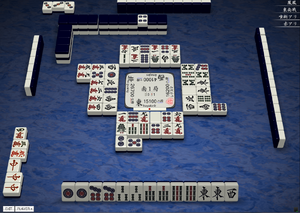Jigoku
| Kanji | 地獄 |
|---|---|
| English | Hell wait |
| Fu | 2 fu |
| Tile types waiting | 1 sided wait |
| Tiles available | 1 tile |
| Pattern example |
|
| Tenhou.net example |
Jigoku 「地獄」 is a special case of tanki wait where two of the winning tiles are visible to all the players by being in a discard pool or used a dora indicator.
Background
The meaning of jigoku wait has undergone some changes over time. It commonly refers to any tanki wait as long as two copies of the winning tiles are visible, but it used to refer only to the case where the winning tile is shaa (「西」 or west) or other honor tile. Some people now started to use the term to refer to non-tanki waits where there is only one winning tile left. This usage is technically incorrect and misleading for the following reason. The basic idea behind jigoku wait is that the winning tile appears safe in the eyes of the opponents, so that whoever deals in to a jigoku wait will feel like they fall to the hell. For example, when two copies of an honor tile are already discarded, the third copy of that honor tile looks safe because it can only be claimed ron if someone has a tanki wait with the fourth copy of it.
Wait strength
Aside from karaten, this is the weakest choice for a wait, because of the number of available tiles to win: one. However, the solitary tile may actually be strong, as players may view it as a safe tile; and therefore, one player may discard it. The wait would be better still with the addition of suji and/or kabe, or even with an honor tile with two already discarded. In essence, choosing this wait may come in the form of a trap, luring unsuspecting players. This wait is best used for emergency situations, such as being in last place at oorasu and other dire circumstances.
External links

| ||||||||||||||||||||||
